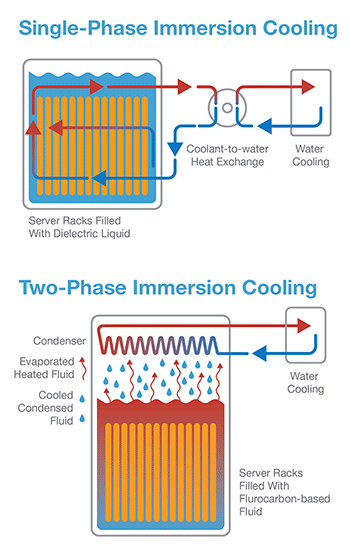- myLubrizol
-
-
Search Immersion Cooling
As demand for cloud computing and other data-intensive web services continues to skyrocket, data center managers are tasked with delivering more computing power.
Meeting those needs comes with its share of challenges. Data centers need to get more from the IT infrastructure they already have in place, while strategically building upon it. Importantly, as computing power increases, so does the heat generated by next-generation servers—and the right cooling technology is required to maintain optimal environmental conditions.
When it comes to data center cooling, operators and managers have options. But not all of them are created equal. Let’s run down today’s commonly available cooling strategies, as well as their pros and cons:

The most conventional method for maintaining optimal environmental conditions, air-cooling systems have been around for decades. These systems release cool air into a space making it available in the cool aisle, allowing the IT hardware to draw it in through the front of the hardware and across the components before ejecting it into the hot aisle. That hot air is then returned, cooled, and delivered back into the data center, completing the cycle.
These systems, however, are quickly becoming inadequate to manage the growing workloads and heat production of modern data center equipment. Traditionally, server configurations reaching 10 kilowatts of power were considered high-density, but tomorrow, extreme-density configurations can top out at 40 kilowatts—a number fundamentally untenable for traditional air-cooling methods. Simply put, the amount of heat coming from higher-power systems is too great for air cooling to be effective or efficient.
Cold plates work by absorbing and dissipating heat through closed-loop liquid-cooling systems. More efficient and compact than traditional air-cooling systems, they offer some clear advantages for data center managers.
However, they can be expensive and rely on a steady supply of water. Tubes and water pumps have the potential to corrode over time, increasing the risk of leaks in spaces filled with electronics.
 Immersion Cooling for Data Centers: A True Breakthrough
Immersion Cooling for Data Centers: A True BreakthroughLiquid immersion cooling is a technology gaining adoption as a practical option for overcoming data center heat issues and the subsequent loss of rack density. Some of tech’s biggest names are taking advantage, and demand is only growing.
Immersion cooling applications submerge computer components in a nonconducting dielectric fluid. Two types of immersion cooling systems are in use today: single-phase and two-phase. Though both methods involve fully submerging hardware in fluid, each approach differs significantly.
In single-phase immersion cooling, hardware is submerged in a dielectric fluid that makes direct contact with the IT equipment, conducting heat away as the fluid flows through a heat rejection mechanism. Organic or halogenated fluids may both be used in this application, although the latter are typically associated with higher cost and a less favorable environmental sustainability profile.
In two-phase cooling, a fluorocarbon-based fluid readily boils when in contact with equipment hot spots, transitioning the fluid from a liquid to a vapor that can be condensed in a heat exchanger and recirculated into the cooling tank. This phase change of liquid to gas allows the fluid to draw large amounts of heat from the equipment, but also requires integration of system design elements to facilitate the transition and a sealed system to prevent costly fluid loss from evaporation.
For data centers, both setups can lead to major benefits, including:
For a deep dive into immersion cooling technology, read our white paper here.

Single-phase systems present some unique advantages versus two-phase—most importantly of which is the ability to tailor cooling fluids for specific performance characteristics.
For example, copper is very prevalent in server systems and is particularly susceptible to corrosion when exposed to oil or water. This means that corrosion performance is a critical characteristic, enabled by specific chemistries and corrosion inhibitors that imbue the fluid with the ability to stop corrosion before it hampers a server system.
Elsewhere, fluid durability is a critical characteristic for immersion cooling. Ideally, your fluid should last the life of the server system it is cooling, reducing the need for periodic change outs, which take up time and maintenance. This performance characteristic works both ways, too—as power demands increase, next-generation fluids should be able to help extend the useful life expectancy of the hardware.
Immersion cooling is separating itself from other technologies and is set to be the standard for data center cooling in the near future. For data center managers, it’s not worth getting left behind.
CompuZol™ immersion fluid solution by Lubrizol can help you get more from your server infrastructure as demand continues to skyrocket. Our fluid engineers can work collaboratively with you to identify your needs and deliver a complete solution along with ongoing support. Contact your Lubrizol representative to find out how CompuZol can transform your operations today.